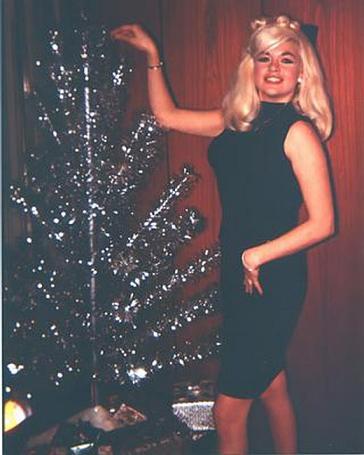Tom of Finland Christmas
Things have felt rushed and chaotic since Autumn 2012.
First DJ’ing at Bestival, followed by a long weekend in Paris in September 2012, then two weeks in Canada
(I got back 2 November). A couple of draining weeks of jetlag and cold ensued
after that. Next thing I know, we're
hurtling towards Christmas!
My mind has felt fogged-over and distracted lately,
but there is a backlog of stuff I want to blog about. So this entry will be a
bit of an epic catch-up about various random (schizophrenic?) things that have preoccupied
me over the past few months.
/ Gee: Do you think he dresses to the left? /
Friday 19 October 2012 was the opening night launch party
for an exhibition of the red-hot 1950s beefcake / physique pin-up photography
of John Palatinus at the Space Station Sixty Five gallery in London. Needless
to say my friends and I were there. I’ve long been an admirer of Palatinus’s
work, and photos of naked men and free booze are two of my favourite things in
life. As a bonus, Palatinus (now an impressively dapper 83-year old) and his curator
and archivist Alan Harmon were there in person (and very articulate and affable
they were, too). Anyway, the party was a blast.

/ Photographer John Palatinus and curator Alan Harmon /

/ Christopher and I in front of one our favourite shots /
Palatinus’s 1950s bodybuilder rockabilly pin-ups may be
slathered in baby oil and virtually naked except for engineer boots or a sailor's cap, often with
ropes or chains coiled around them, but they still retain a sweetness and naivety
which would be impossible to capture today. (This is the same quality that also makes mid-century female
cheesecake photos of, say, Bettie Page or Jayne Mansfield so beguiling.
It’s hard to define: an un-ironic lack of self-consciousness?).
More examples of Palatinus at his best, all taken circa the late 1950s
I find this model (apparently named Bob Ireland)
particularly heart-melting. He looks so au courant with his sexy, scruffy
little beard. If he rocked up to The Joiner’s Arms or The George & Dragon
in Shoreditch looking like that, he wouldn’t be buying his own drinks all night
Palatinus was arrested on
obscenity charges in 1959 at the height of the McCarthy witch hunt era. Most of his work was seized and destroyed. What
was especially fascinating about the exhibit (which closed on 18 November 2012)
was its inclusion of contemporary newspaper articles covering Palatinus’s
arrest: the press didn’t just publish his name and home address – it also
detailed the full names, addresses and occupations of his mail order clientele!
It makes you shudder thinking about the shame and destroyed lives of these
presumably closeted men all over the US in the repressed 1950s, for something so innocuous. We’ve come
a long way, baby!
Afterward, my friends and I continued the party at ultra rough,
old-school boozer The Little Apple nearby in Kennington. Christopher embraced
the spirit of things by donning a sailor cap. (The cap is actually mine! I lent it to him; Christopher was going to be playing a
sailor in a pop video).

Read more about John Palatinus on his
official website. Alan Harmon's
V-M-P Vintage Male Physique blog is a real treasure trove; I highly encourage you to check it out. You can see more of my photos from the night on my
flickr page.
I avidly follow Decaying Hollywood Mansions in all its manifestations (it's a Facebook group,
a tumblr page and a blog). Think of it as a guide to the haunted, eerie and crepuscular
subterranean underbelly of Old Hollywood, in the vein of Kenneth Anger’s
Hollywood Babylon. A few months ago they posted some intriguing photos of the
actress Merle Oberon in the long-forgotten, very kitsch-looking 1946 Technicolour
exotica oddity A Night in Paradise. (It looks like the cinematic equivalent of
Yma Sumac's delirious music).

Merle Oberon in
A Night in Paradise (1946)
I hadn’t thought of Oberon in ages and it reminded me of her
strange, secretive life story. Her exact origins will always be clouded in
mystery, but it appears the Anglo-Indian Oberon was born in 1911 in Bombay of
mixed race heritage (her mother was Indian, her father British). For the
entirety of her life (she died aged 68 in 1979) Oberon denied her biracial
background and “passed herself off” as white. When her dark-skinned and sari-clad
mother eventually moved with Oberon to her Hollywood mansion, Oberon told
everyone she was her maid! Oberon was widely regarded as one of the great
beauties of her era; apparently even Marlene Dietrich was jealous of her. To
modern eyes, she certainly looks like an exquisite Asian woman (film historian
John Kobal would accurately describe her exotic beauty as “jasmine scented”).
Nonetheless, it wasn’t
until years after Oberon’s death that her secret was unmasked in a
biography I remember reading as a teenager. (In this regard, her story echoes that
of musician Korla Pandit's).
 An almost scary 1930s portrait of Merle Oberon. The lighting makes her look like an escapee from a Josef Von Sternberg film
An almost scary 1930s portrait of Merle Oberon. The lighting makes her look like an escapee from a Josef Von Sternberg film
Who are we to judge? In the 1930s miscegenation was strictly
taboo; a biracial race actress could never have become a mainstream star. Oberon
emerged from an impoverished background and apparently had a steely
determination to succeed. It could be that Oberon was a far better actress in real
life than she ever was onscreen. The great irony is that if Oberon is remembered
at all today (she’s mostly not, except for playing Cathy opposite Laurence
Olivier’s Heathcliff in the 1939 adaptation of Wuthering Heights), it’s not for
any of her film performances but for being the half-Indian actress who painstakingly
concealed her ethnicity – the one thing she didn’t want anyone to know about!
The great Self-Styled Siren film blog devoted a whole entry to
Oberon’s story a while back, comparing her to the doomed and conflicted mixed
race character Sarah Jane in the 1959 Douglas Sirk melodrama Imitation of Life. It’s
the balanced and ultimately sympathetic account that Oberon deserves.
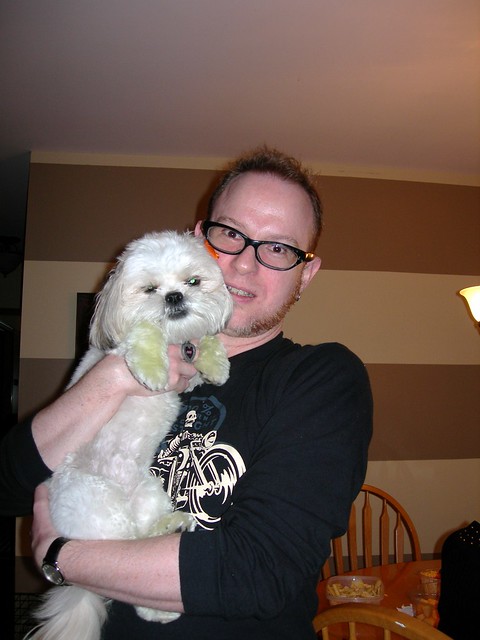
Coco and I at my mother's place. Re her green-ish paws: my brother-in-law had just mowed the lawn, the grass was damp and Coco ran through it
Since moving to London twenty years ago
now, I make an annual trip back to visit my family in Canada. I usually aim to
get there around the beginning of September when "peak season" is
over but the weather is still relatively summer-y and I can swim (my mother
lives walking distance from the beach). This year the airfare was so
prohibitive I had to wait until late October (I was there 22 October – 1
November), which meant I was home for Halloween. I divided my time between my
mother’s place in Norway Bay, Quebec and my sister’s in the suburbs outside
Ottawa, and spent most of it sleeping (averaging 11 hours a night), eating
(I’ve gained about ten pounds), playing with my nieces (Maya, 10 and Miranda,
8) and getting to know their new dog – an adorable Shih Tzu called Coco.
 My mother and I
I’d forgotten what a big deal Halloween is
in North America. Check out my flickr page for how elaborately the people of suburban
Ottawa decorate their houses for Halloween (and loads of shots of the many
moods of Coco).
My mother and I
I’d forgotten what a big deal Halloween is
in North America. Check out my flickr page for how elaborately the people of suburban
Ottawa decorate their houses for Halloween (and loads of shots of the many
moods of Coco).
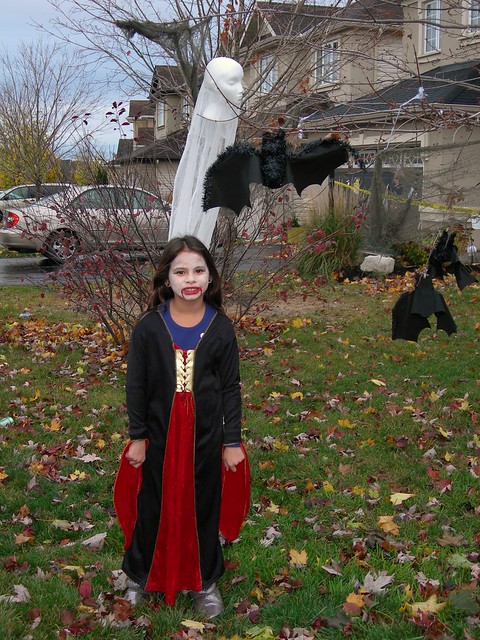
Vampire princess Miranda in her front yard on Halloween night
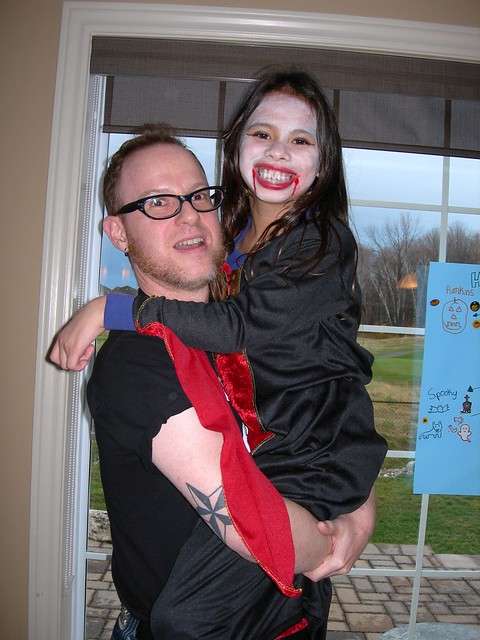
Miranda and I
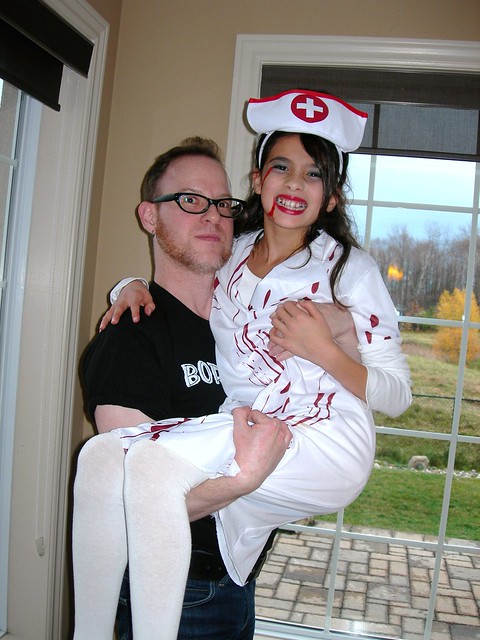
Maya and I. (Her costume was "bloody nurse")
 Portrait of Warhol drag queen Jackie Curtis by Leee Black Childers. No one documented the iconic Warhol drag Superstars (Curtis, Holly Woodlawn and Candy Darling) better than Leee
Portrait of Warhol drag queen Jackie Curtis by Leee Black Childers. No one documented the iconic Warhol drag Superstars (Curtis, Holly Woodlawn and Candy Darling) better than Leee
On 5 December 2012 my friends Christopher, Mari and I went
to the launch party for Leee Black Childer’s book Drag Queens, Rent Boys, Pick
Pockets, Junkies, Rockstars and Punks at The Vinyl Factory (a chi chi art
gallery in South Kensington). In case Leee needs any introduction: In the 1960s
he was one of Andy Warhol’s assistants; later on he was involved in the
management of the music careers of the likes of David Bowie, Iggy and The
Stooges, The Heartbreakers and Levi and The Rockcats. Throughout, he was
photographing everything: the Warhol Superstars, the whole decadent Max’s
Kansas City and Chelsea Hotel milieu, glam rock, and the emergence of punk on both sides of the
Atlantic. A natural raconteur, in the essential oral histories of punk (like
England's Dreaming and Please Kill Me), Leee is always interviewed as one of
the key witnesses and scene makers. His wonderfully grainy, gritty and
evocative portraits of the Sex Pistols and Warhol drag queen Superstars in
particular are like cat nip for me. (Obviously there were other photographers
documenting the Warhol scene at the time, but Leee’s photos of Curtis, Candy
Darling and Holly Woodlawn have a real intimacy and rapport). I’ve known Leee
for several years now via mutual friends and usually wind up seeing him when he
comes to London (he’s based in New York). It was really gratifying to finally see
his work get the deluxe coffee table book treatment (and accompanying exhibit)
it merits.
Needless to say, I snapped a few shots on the night.Before heading to Leee’s party, we assembled for Happy Hour
drinks at Simmons Bar in Kings Cross (great place; I highly recommend it. It has a skull-shaped disco ball!). They
had a lurid hot pink (or should that be fuchsia?) acrylic Christmas tree in the corner that
transfixed us. So artificial! So Jayne Mansfield! And so futuristic:
it was like a Space Age Barbarella Christmas.

Christopher and the glamorous Mari

Christopher and I

Mari and Leee

Leee, Mari and novelist / journalist Rupert Smith

Leee and I way back in September 2008 at Cockabilly at The Moustache Bar in Dalston
 I can claim to actually have been photographed by the great Leee Black Childers myself, once! He took this shot at the club night Polari at the sadly now defunct Trash Palace bar on Wardour Street. This was also taken in September 2008. Left to right: Rupert Smith, Christian Rodrigues and me
Check out photos from the last time Leee Black Childers was in town on my flickr page
I held my annual Christmas cocktail party on 5 December. As
promised (threatened?) on the Facebook events page:
I can claim to actually have been photographed by the great Leee Black Childers myself, once! He took this shot at the club night Polari at the sadly now defunct Trash Palace bar on Wardour Street. This was also taken in September 2008. Left to right: Rupert Smith, Christian Rodrigues and me
Check out photos from the last time Leee Black Childers was in town on my flickr page
I held my annual Christmas cocktail party on 5 December. As
promised (threatened?) on the Facebook events page:
Right: Am thinking of having another intimate Christmas
cocktail party chez moi again this year. For those of you who came last year,
you know what to expect: I live in a shoe box! Seating is minimal, so you will
have no choice but to stand and mingle for the most part (or sit on the floor).
The couch represents the elite VIP area. Kitsch and abrasive 1950s and 60s Christmas music
will be cranked up LOUD (my CD player is fixed!). I don't "do" food, so
eat beforehand, although there will be olives and crisps! (I make these things
sound so tempting, don't I?). I will be making snowballs, but I only have one
bottle of Advocaat and I ain't buying another one, so if you want snowballs,
arrive early to avoid disappointment. After the snowballs, am thinking oceans
of icy Cava and maybe Prosecco!
Anyway, the party really swung. In fact it rocked! A week later I was
still finding stray bits of broken glass, wasabi peas and roasted peanuts under the sofa bed. Here
are a few shots from the night (there’s loads more on my flickr page). Look at
these and try to imagine how hung-over I felt that Sunday. Then multiply that
by ten.

Paul smoking his head off

Sally and Paddy

Lauren and I, Part 1

Lauren and I, Part 2

Marlene Dietrich, Eric and Divine: all in one shot

Eric and Sally

Christopher and Lauren. They are in a band together called Spanking Machine, by the way, destined to be big in 2013. (Don't you love how the red dumb bells in the corner match Lauren's dress perfectly? What's
that about?!)
 Dez and Paul. I love this shot of Paul: at his most louche, gesticulating wildly, smouldering cigarette on the go
Right: I’ve pretty much brought things up to date. There was
no Dr Sketchy at all this month, so I didn’t DJ any Christmas music which felt
a bit sad. The most exciting but nerve-wracking bit of upcoming news is that I’m
launching my club night Lobotomy Room on Saturday 29 December 2012! It’s happening at Paper Dress Vintage in Shoreditch. The organiser / promoter Steve
is going to be away that weekend, he had nothing scheduled for that night and
offered it to me, to launch my night in a low-key, no pressure way. (I know it’s
very likely loads of people will be away for the holidays. London can be quiet
the week between Christmas and New Years). Fingers crossed, if this goes well
Lobotomy Room will become a regular monthly occurrence in 2013. Wish me luck: I’m
shitting bricks / sweating bullets / having kittens trouble-shooting all the
things that could go wrong! Hopefully my next blog will be posting the set list
from the first night of Lobotomy Room.
Lobotomy Room ... it's coming!
Dez and Paul. I love this shot of Paul: at his most louche, gesticulating wildly, smouldering cigarette on the go
Right: I’ve pretty much brought things up to date. There was
no Dr Sketchy at all this month, so I didn’t DJ any Christmas music which felt
a bit sad. The most exciting but nerve-wracking bit of upcoming news is that I’m
launching my club night Lobotomy Room on Saturday 29 December 2012! It’s happening at Paper Dress Vintage in Shoreditch. The organiser / promoter Steve
is going to be away that weekend, he had nothing scheduled for that night and
offered it to me, to launch my night in a low-key, no pressure way. (I know it’s
very likely loads of people will be away for the holidays. London can be quiet
the week between Christmas and New Years). Fingers crossed, if this goes well
Lobotomy Room will become a regular monthly occurrence in 2013. Wish me luck: I’m
shitting bricks / sweating bullets / having kittens trouble-shooting all the
things that could go wrong! Hopefully my next blog will be posting the set list
from the first night of Lobotomy Room.
Lobotomy Room ... it's coming!
Anyway, this is almost certainly my last blog before 25 December, so Merry Christmas to everyone! I know I post this pic of Jayne Mansfield every year but it never gets tired.
